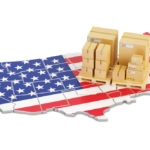The United States’ recent imposition of tariffs on imports from China, Mexico, and Canada has sent ripples through the global trade landscape. While these tariffs are primarily aimed at protecting domestic industries and addressing trade imbalances, they could inadvertently create opportunities for other economies, including Pakistan. As an import-driven economy, Pakistan stands to benefit from shifts in global trade dynamics. In this blog post, we’ll explore how US tariffs on these countries could positively impact Pakistan’s economy, the sectors likely to benefit, and the challenges that need to be addressed to capitalize on these opportunities.
Key Highlights
- US Tariffs: The US has imposed tariffs ranging from 10% to 25% on imports from China, Mexico, and Canada, affecting industries like steel, aluminum, textiles, and electronics.
- Opportunity for Pakistan: Pakistan could emerge as an alternative supplier for goods affected by these tariffs.
- Potential Sectors: Textiles, agriculture, and manufacturing are likely to benefit the most.
- Challenges: Infrastructure limitations, trade barriers, and competition from other countries could hinder Pakistan’s ability to fully capitalize on these opportunities.
How US Tariffs Could Benefit Pakistan
1. Increased Demand for Pakistani Exports
As US tariffs make imports from China, Mexico, and Canada more expensive, American businesses may seek alternative suppliers. Pakistan, with its competitive labor costs and established industries, is well-positioned to fill this gap.
- Example: Pakistani textiles, already a major export, could see increased demand as US buyers look for cost-effective alternatives to Chinese products.
2. Diversification of Trade Partnerships
The tariffs could encourage Pakistan to diversify its trade partnerships and reduce reliance on traditional markets. By strengthening trade ties with the US, Pakistan can access a larger and more lucrative market.
- Statistic: Pakistan’s exports to the US currently stand at $4.5 billion, with significant potential for growth in sectors like textiles, leather, and sports goods.
3. Boost to Local Industries
Increased demand for Pakistani goods could stimulate growth in local industries, leading to job creation and economic development.
- Example: The agriculture sector could benefit from increased exports of rice, mangoes, and other products to the US.
4. Attracting Foreign Investment
As global supply chains shift, Pakistan could attract foreign investment from companies looking to establish manufacturing hubs in tariff-advantaged locations.
- Example: Chinese manufacturers affected by US tariffs might consider relocating production to Pakistan to maintain access to the US market.
Sectors Likely to Benefit
1. Textiles and Apparel
Pakistan is already a major exporter of textiles and apparel, accounting for 60% of total exports. US tariffs on Chinese textiles could open up new opportunities for Pakistani manufacturers.
- Opportunity: Increased demand for Pakistani cotton, garments, and home textiles in the US market.
2. Agriculture
Pakistan’s agricultural sector could benefit from increased exports of rice, mangoes, and other products to the US.
- Opportunity: Expanding exports of Basmati rice, which is highly sought after in the US.
3. Manufacturing
The manufacturing sector, particularly in areas like sports goods, leather products, and surgical instruments, could see increased demand from the US.
- Opportunity: Pakistani surgical instruments, already popular globally, could gain a larger share of the US market.
4. Information Technology (IT) and Services
The IT sector could benefit from increased outsourcing opportunities as US companies look for cost-effective alternatives to Chinese and Mexican services.
- Opportunity: Expanding Pakistan’s IT exports, which currently stand at $2.6 billion.
Challenges and the Way Forward
While the US tariffs present significant opportunities, Pakistan must address several challenges to fully capitalize on them:
1. Infrastructure Limitations
Poor infrastructure, including transportation and energy shortages, could hinder Pakistan’s ability to meet increased demand.
- Solution: Invest in infrastructure development, particularly in transportation and energy, to support industrial growth.
2. Trade Barriers
Non-tariff barriers, such as complex customs procedures and quality standards, could limit Pakistan’s access to the US market.
- Solution: Streamline customs processes and align quality standards with international requirements.
3. Competition from Other Countries
Pakistan faces competition from other countries, such as Vietnam, India, and Bangladesh, which are also vying to replace Chinese and Mexican exports.
- Solution: Focus on product differentiation, quality improvement, and competitive pricing to stand out in the global market.
4. Skill Gaps
A lack of skilled labor in key sectors could limit Pakistan’s ability to meet the demands of the US market.
- Solution: Invest in education and vocational training programs to bridge the skills gap.
Strategic Recommendations
1. Enhance Trade Diplomacy
Pakistan should actively engage with the US to negotiate favorable trade agreements and reduce non-tariff barriers.
2. Promote Export-Oriented Industries
The government should provide incentives and support to export-oriented industries, particularly textiles, agriculture, and IT.
3. Improve Infrastructure
Invest in infrastructure development to ensure efficient transportation and energy supply for industries.
4. Leverage CPEC
Utilize the China-Pakistan Economic Corridor (CPEC) to attract foreign investment and establish manufacturing hubs.
Conclusion
The US tariffs on China, Mexico, and Canada present a unique opportunity for Pakistan to strengthen its position in the global trade landscape. By addressing challenges and leveraging its competitive advantages, Pakistan can boost exports, attract foreign investment, and stimulate economic growth. This is a pivotal moment for Pakistan’s economy, and with the right strategies, the country can emerge as a key player in the global market.






